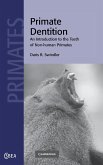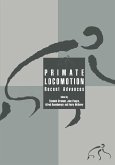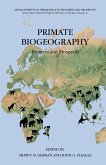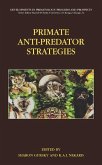Fred Anapol / Rebecca Z. German / Nina G. Jablonski (eds.)Form, Function, and Behavior
Shaping Primate Evolution
Form, Function, and Behavior
Herausgeber: Anapol, Fred; Jablonski, Nina G.; German, Rebecca Z.
Fred Anapol / Rebecca Z. German / Nina G. Jablonski (eds.)Form, Function, and Behavior
Shaping Primate Evolution
Form, Function, and Behavior
Herausgeber: Anapol, Fred; Jablonski, Nina G.; German, Rebecca Z.
- Gebundenes Buch
- Merkliste
- Auf die Merkliste
- Bewerten Bewerten
- Teilen
- Produkt teilen
- Produkterinnerung
- Produkterinnerung
This state-of-the-art book on how form is described in primate biology, and its consequences for function and behavior, includes contributions by internationally renowned researchers of quantitative primate evolutionary morphology. Each chapter elaborates upon the analysis of the form-function-behavior triad. The book is unique, therefore, not only in the diversity of the topics discussed, but in the range of levels of biological organization addressed--from cellular morphometrics to the evolution of primate ecology.
Andere Kunden interessierten sich auch für
![Primate Dentition Primate Dentition]() Daris R. SwindlerPrimate Dentition195,99 €
Daris R. SwindlerPrimate Dentition195,99 €![Primate Locomotion Primate Locomotion]() Elizabeth Strasser / John Fleagle / Alfred L. Rosenberger / Henry McHenry (eds.)Primate Locomotion149,99 €
Elizabeth Strasser / John Fleagle / Alfred L. Rosenberger / Henry McHenry (eds.)Primate Locomotion149,99 €![Primate Biogeography Primate Biogeography]() Primate Biogeography75,99 €
Primate Biogeography75,99 €![Primate Communities Primate Communities]() J. G. Fleagle / Charles Janson / Kaye Reed (eds.)Primate Communities128,99 €
J. G. Fleagle / Charles Janson / Kaye Reed (eds.)Primate Communities128,99 €![Primate Communities Primate Communities]() J. G. Fleagle / Charles Janson / Kaye Reed (eds.)Primate Communities48,99 €
J. G. Fleagle / Charles Janson / Kaye Reed (eds.)Primate Communities48,99 €![Primate Biogeography Primate Biogeography]() Shawn M. Lehman / John Fleagle (eds.)Primate Biogeography78,99 €
Shawn M. Lehman / John Fleagle (eds.)Primate Biogeography78,99 €![Primate Anti-Predator Strategies Primate Anti-Predator Strategies]() Primate Anti-Predator Strategies214,99 €
Primate Anti-Predator Strategies214,99 €-
-
-
This state-of-the-art book on how form is described in primate biology, and its consequences for function and behavior, includes contributions by internationally renowned researchers of quantitative primate evolutionary morphology. Each chapter elaborates upon the analysis of the form-function-behavior triad. The book is unique, therefore, not only in the diversity of the topics discussed, but in the range of levels of biological organization addressed--from cellular morphometrics to the evolution of primate ecology.
Hinweis: Dieser Artikel kann nur an eine deutsche Lieferadresse ausgeliefert werden.
Hinweis: Dieser Artikel kann nur an eine deutsche Lieferadresse ausgeliefert werden.
Produktdetails
- Produktdetails
- Verlag: Cambridge University Press
- Seitenzahl: 444
- Erscheinungstermin: 13. August 2014
- Englisch
- Abmessung: 235mm x 157mm x 28mm
- Gewicht: 790g
- ISBN-13: 9780521811071
- ISBN-10: 0521811074
- Artikelnr.: 21800537
- Herstellerkennzeichnung
- Libri GmbH
- Europaallee 1
- 36244 Bad Hersfeld
- gpsr@libri.de
- Verlag: Cambridge University Press
- Seitenzahl: 444
- Erscheinungstermin: 13. August 2014
- Englisch
- Abmessung: 235mm x 157mm x 28mm
- Gewicht: 790g
- ISBN-13: 9780521811071
- ISBN-10: 0521811074
- Artikelnr.: 21800537
- Herstellerkennzeichnung
- Libri GmbH
- Europaallee 1
- 36244 Bad Hersfeld
- gpsr@libri.de
List of contributors; Preface: shaping primate evolution Fred Anapol,
Rebecca Z. German and Nina G. Jablonski; 1. Charles Oxnard: an appreciation
Matt Cartmill; Part I. Craniofacial Form and Variation: 2. The ontogeny of
sexual dimorphism: the implications of longitudinal vs. cross-sectional
data for studying heterochrony in mammals Rebecca Z. German; 3. Advances in
the analysis of form and pattern: facial growth in African colobines Paul
O'Higgins and Ruilang L. Pan; 4. Cranial variation among the Asian
colobines Ruilang L. Pan and Colin P. Groves; 5. Craniometric variation in
early Homo compared to modern gorillas: a population-thinking approach
Joseph M. A. Miller, Gene H. Albrecht and Bruce Gelvin; Part II. Organ
Structure, Function, and Behavior: 6. Fiber architecture, muscle function,
and behavior: gluteal and hamstring muscles of semiterrestrial and arboreal
guenons Fred Anapol, Nazima Shahnoor and J. Patrick Gray; 7. Comparative
fiber-type composition and size in the antigravity muscles of primate limbs
Françoise K. Jouffroy and Monique F. Médina; 8. On the nature of
morphology: selected canonical variates analyses of the hominoid hindtarsus
and their interpretation Robert S. Kidd; 9. Plant mechanics and primate
dental adaptations: an overview Peter W. Lucas; 10. Convergent evolution in
brain 'shape' and locomotion in primates Willem de Winter; Part III. In
Vivo Organismal Verification of Functional Models: 11. Jaw adductor force
and symphyseal fusion William L. Hylander, Christopher J. Vinyard, Matthew
J. Ravosa, Callum F. Ross, Christine E. Wall and Kirk R. Johnson; 12. Hind
limb drive, hind limb steering? Functional differences between fore and
hind limbs in chimpanzee quadrupedalism Yu Li, Robin Huw Crompton, Weijie
Wang, Russell Savage and Michael M. Günther; Part IV. Theoretical Models in
Evolutionary Morphology: 13. Becoming bipedal: how do theories of
bipedalization stand up to anatomical scrutiny? Nina G. Jablonski and
George Chaplin; 14. Modeling human walking as an inverted pendulum of
varying length Jack T. Stern Jr, Brigitte Demes and D. Casey Kerrigan; 15.
Estimating the line of action of posteriorly inclined resultant jaw muscle
forces in mammals using a model that minimizes functionally important
distances in the skull Walter Stalker Greaves; Part V. Primate Diversity
and Evolution: 16. The evolution of primate ecology: patterns of geography
and phylogeny John G. Fleagle and Kaye E. Reed; 17. Charles Oxnard and the
aye-aye: morphometrics, cladistics, and two very special primates Colin P.
Groves; 18. From 'mathematical dissection of anatomies' to morphometrics: a
twenty-first-century appreciation of Charles Oxnard Fred L. Bookstein and
F. James Rohlf; 19. Design, level, interface, and complexity: morphometric
interpretation revisited Charles E. Oxnard; 20. Postscript and
acknowledgements Charles E. Oxnard; Index.
Rebecca Z. German and Nina G. Jablonski; 1. Charles Oxnard: an appreciation
Matt Cartmill; Part I. Craniofacial Form and Variation: 2. The ontogeny of
sexual dimorphism: the implications of longitudinal vs. cross-sectional
data for studying heterochrony in mammals Rebecca Z. German; 3. Advances in
the analysis of form and pattern: facial growth in African colobines Paul
O'Higgins and Ruilang L. Pan; 4. Cranial variation among the Asian
colobines Ruilang L. Pan and Colin P. Groves; 5. Craniometric variation in
early Homo compared to modern gorillas: a population-thinking approach
Joseph M. A. Miller, Gene H. Albrecht and Bruce Gelvin; Part II. Organ
Structure, Function, and Behavior: 6. Fiber architecture, muscle function,
and behavior: gluteal and hamstring muscles of semiterrestrial and arboreal
guenons Fred Anapol, Nazima Shahnoor and J. Patrick Gray; 7. Comparative
fiber-type composition and size in the antigravity muscles of primate limbs
Françoise K. Jouffroy and Monique F. Médina; 8. On the nature of
morphology: selected canonical variates analyses of the hominoid hindtarsus
and their interpretation Robert S. Kidd; 9. Plant mechanics and primate
dental adaptations: an overview Peter W. Lucas; 10. Convergent evolution in
brain 'shape' and locomotion in primates Willem de Winter; Part III. In
Vivo Organismal Verification of Functional Models: 11. Jaw adductor force
and symphyseal fusion William L. Hylander, Christopher J. Vinyard, Matthew
J. Ravosa, Callum F. Ross, Christine E. Wall and Kirk R. Johnson; 12. Hind
limb drive, hind limb steering? Functional differences between fore and
hind limbs in chimpanzee quadrupedalism Yu Li, Robin Huw Crompton, Weijie
Wang, Russell Savage and Michael M. Günther; Part IV. Theoretical Models in
Evolutionary Morphology: 13. Becoming bipedal: how do theories of
bipedalization stand up to anatomical scrutiny? Nina G. Jablonski and
George Chaplin; 14. Modeling human walking as an inverted pendulum of
varying length Jack T. Stern Jr, Brigitte Demes and D. Casey Kerrigan; 15.
Estimating the line of action of posteriorly inclined resultant jaw muscle
forces in mammals using a model that minimizes functionally important
distances in the skull Walter Stalker Greaves; Part V. Primate Diversity
and Evolution: 16. The evolution of primate ecology: patterns of geography
and phylogeny John G. Fleagle and Kaye E. Reed; 17. Charles Oxnard and the
aye-aye: morphometrics, cladistics, and two very special primates Colin P.
Groves; 18. From 'mathematical dissection of anatomies' to morphometrics: a
twenty-first-century appreciation of Charles Oxnard Fred L. Bookstein and
F. James Rohlf; 19. Design, level, interface, and complexity: morphometric
interpretation revisited Charles E. Oxnard; 20. Postscript and
acknowledgements Charles E. Oxnard; Index.
List of contributors; Preface: shaping primate evolution Fred Anapol,
Rebecca Z. German and Nina G. Jablonski; 1. Charles Oxnard: an appreciation
Matt Cartmill; Part I. Craniofacial Form and Variation: 2. The ontogeny of
sexual dimorphism: the implications of longitudinal vs. cross-sectional
data for studying heterochrony in mammals Rebecca Z. German; 3. Advances in
the analysis of form and pattern: facial growth in African colobines Paul
O'Higgins and Ruilang L. Pan; 4. Cranial variation among the Asian
colobines Ruilang L. Pan and Colin P. Groves; 5. Craniometric variation in
early Homo compared to modern gorillas: a population-thinking approach
Joseph M. A. Miller, Gene H. Albrecht and Bruce Gelvin; Part II. Organ
Structure, Function, and Behavior: 6. Fiber architecture, muscle function,
and behavior: gluteal and hamstring muscles of semiterrestrial and arboreal
guenons Fred Anapol, Nazima Shahnoor and J. Patrick Gray; 7. Comparative
fiber-type composition and size in the antigravity muscles of primate limbs
Françoise K. Jouffroy and Monique F. Médina; 8. On the nature of
morphology: selected canonical variates analyses of the hominoid hindtarsus
and their interpretation Robert S. Kidd; 9. Plant mechanics and primate
dental adaptations: an overview Peter W. Lucas; 10. Convergent evolution in
brain 'shape' and locomotion in primates Willem de Winter; Part III. In
Vivo Organismal Verification of Functional Models: 11. Jaw adductor force
and symphyseal fusion William L. Hylander, Christopher J. Vinyard, Matthew
J. Ravosa, Callum F. Ross, Christine E. Wall and Kirk R. Johnson; 12. Hind
limb drive, hind limb steering? Functional differences between fore and
hind limbs in chimpanzee quadrupedalism Yu Li, Robin Huw Crompton, Weijie
Wang, Russell Savage and Michael M. Günther; Part IV. Theoretical Models in
Evolutionary Morphology: 13. Becoming bipedal: how do theories of
bipedalization stand up to anatomical scrutiny? Nina G. Jablonski and
George Chaplin; 14. Modeling human walking as an inverted pendulum of
varying length Jack T. Stern Jr, Brigitte Demes and D. Casey Kerrigan; 15.
Estimating the line of action of posteriorly inclined resultant jaw muscle
forces in mammals using a model that minimizes functionally important
distances in the skull Walter Stalker Greaves; Part V. Primate Diversity
and Evolution: 16. The evolution of primate ecology: patterns of geography
and phylogeny John G. Fleagle and Kaye E. Reed; 17. Charles Oxnard and the
aye-aye: morphometrics, cladistics, and two very special primates Colin P.
Groves; 18. From 'mathematical dissection of anatomies' to morphometrics: a
twenty-first-century appreciation of Charles Oxnard Fred L. Bookstein and
F. James Rohlf; 19. Design, level, interface, and complexity: morphometric
interpretation revisited Charles E. Oxnard; 20. Postscript and
acknowledgements Charles E. Oxnard; Index.
Rebecca Z. German and Nina G. Jablonski; 1. Charles Oxnard: an appreciation
Matt Cartmill; Part I. Craniofacial Form and Variation: 2. The ontogeny of
sexual dimorphism: the implications of longitudinal vs. cross-sectional
data for studying heterochrony in mammals Rebecca Z. German; 3. Advances in
the analysis of form and pattern: facial growth in African colobines Paul
O'Higgins and Ruilang L. Pan; 4. Cranial variation among the Asian
colobines Ruilang L. Pan and Colin P. Groves; 5. Craniometric variation in
early Homo compared to modern gorillas: a population-thinking approach
Joseph M. A. Miller, Gene H. Albrecht and Bruce Gelvin; Part II. Organ
Structure, Function, and Behavior: 6. Fiber architecture, muscle function,
and behavior: gluteal and hamstring muscles of semiterrestrial and arboreal
guenons Fred Anapol, Nazima Shahnoor and J. Patrick Gray; 7. Comparative
fiber-type composition and size in the antigravity muscles of primate limbs
Françoise K. Jouffroy and Monique F. Médina; 8. On the nature of
morphology: selected canonical variates analyses of the hominoid hindtarsus
and their interpretation Robert S. Kidd; 9. Plant mechanics and primate
dental adaptations: an overview Peter W. Lucas; 10. Convergent evolution in
brain 'shape' and locomotion in primates Willem de Winter; Part III. In
Vivo Organismal Verification of Functional Models: 11. Jaw adductor force
and symphyseal fusion William L. Hylander, Christopher J. Vinyard, Matthew
J. Ravosa, Callum F. Ross, Christine E. Wall and Kirk R. Johnson; 12. Hind
limb drive, hind limb steering? Functional differences between fore and
hind limbs in chimpanzee quadrupedalism Yu Li, Robin Huw Crompton, Weijie
Wang, Russell Savage and Michael M. Günther; Part IV. Theoretical Models in
Evolutionary Morphology: 13. Becoming bipedal: how do theories of
bipedalization stand up to anatomical scrutiny? Nina G. Jablonski and
George Chaplin; 14. Modeling human walking as an inverted pendulum of
varying length Jack T. Stern Jr, Brigitte Demes and D. Casey Kerrigan; 15.
Estimating the line of action of posteriorly inclined resultant jaw muscle
forces in mammals using a model that minimizes functionally important
distances in the skull Walter Stalker Greaves; Part V. Primate Diversity
and Evolution: 16. The evolution of primate ecology: patterns of geography
and phylogeny John G. Fleagle and Kaye E. Reed; 17. Charles Oxnard and the
aye-aye: morphometrics, cladistics, and two very special primates Colin P.
Groves; 18. From 'mathematical dissection of anatomies' to morphometrics: a
twenty-first-century appreciation of Charles Oxnard Fred L. Bookstein and
F. James Rohlf; 19. Design, level, interface, and complexity: morphometric
interpretation revisited Charles E. Oxnard; 20. Postscript and
acknowledgements Charles E. Oxnard; Index.









